Kenmun
Posted by: Loren Coleman on March 1st, 2009
Guest blogger Brent Swancer shares what he knows about the Kenmun. My appreciation for his contribution. ~ Loren.
Kenmun
by Brent Swancer
Recently, I wrote here at Cryptomundo about the mysterious Yamapikarya of Iriomote island. However, this mystery cat is not the only cryptid that makes its home in Japan’s Ryukyu Islands. On the island of Amami Oshima (Amami big island), there have long been stories of a hairy, monkey-like creature known as the Kenmun. Let us now take a look once more into these Southern islands of Japan, and the mysteries they hide.
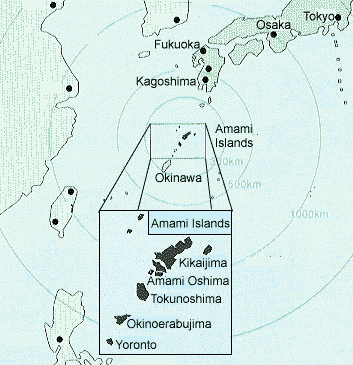
Amami Oshima is the largest island in the Amami chain of islands, in the Northern part of the Ryukyu archipelago. The island is part of Kagoshima prefecture rather than Okinawa prefecture, which comprises the Southern part of the archipelago. It is 274 square miles in area, with mountainous, forested terrain.
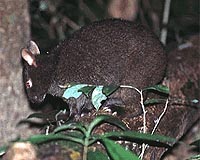
Amami Oshima is notable for being the home of the Amami black rabbit (Pentalagus furnessi), shown above, a rabbit, which demonstrates apparent hare ancestral traits, found only on this island and Toku-no island, and no where else in the world.
The Kenmun, also known as the Kunmon, Kunmu, and Nebuzawa, is said to be around 1 to 1.3 meters tall, about the size of a 5 or 6 year old child. It is covered in kinky, red or black hair, that looks mussed and dirty. The Kenmun has a face that is most often described as being like that of a monkey, but also sometimes as dog-like. It is a nocturnal animal, with eyes that glow red in the dark when light catches them. The creature’s arms are disproportionately long compared to the legs, and it is said to be an agile and powerful climber.
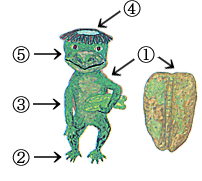
The traditional appearance of a Kappa, with the key to the above drawing:
1) Shell
2) Webbed hands and feet
3) Elastic arms
4) Plate (When there is water in this plate, the Kappa has amazing strength.)
5) A tapering mouth
The Kenmun is mostly thought of as another type of Kappa (a sort of Japanese water imp), and old folkloric stories on the animal even describe it as having a cup-like thing on its head, just like the Kappa.

The Kenmun is said to be highly arboreal, making its home primarily in banyan trees, yet it is also a good swimmer, and is thought to prefer habitat near water such as rivers or the sea. It’s favorite foods are said to be fish, crab, and octopus, as well as shellfish and snails. Indeed it is thought that a sure sign of a Kenmun’s tree is the shellfish and snail shells littering the area under it. The creature is said to be particularly fond of fish eyes, which it will pop out and eat with relish.
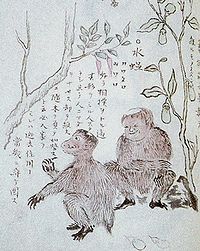
A prominent feature of the Kenmun is its powerful stench, variously described as smelling like goat, horse, and rotting yams. The smell is believed to instill great fear in animals that come into contact with it, and there have been modern accounts of this. For instance, in 1973, a rancher reported that as he moved his cows to pasture, they suddenly became spooked and refused to move. It was strange since they had never acted this way before. The curious rancher took a look around and didn’t see anything unusual, but he became aware of a thick, pungent stench in the air. It was not until the smell passed that the cows finally regained their composure. Similar effects have often been reported on horses and dogs.
Although mostly considered as harmless, the Kenmun has a somewhat bad reputation nevertheless. In folklore, it was thought to be a trickster as well as a bit headstrong, known to challenge travelers to wrestling matches. In more modern reports, the creatures are said to steal fish or bait from fishermen, and indeed Kenmun are most often seen by fisherman fishing at night. Some more violent behavior includes shrieking at passerby and hurling rocks or stones. There have even been accounts of homes being besieged by rock throwing Kenmun. One man told of seeing a small, dark form sitting alone on the beach one evening. When he called out to it, the figure suddenly whirled around in surprise and the man was astonished to see that it was a hairy creature like a small ape. This creature proceeded to start throwing rocks at the terrified man, even chasing him to his nearby home, where it continued to pelt the dwelling with rocks for some time before leaving the area.
Although the Kenmun has long been sighted by islanders, physical evidence has mostly taken the form of footprints that turn up from time to time.
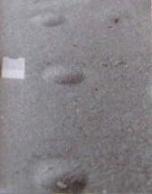
In November, 1986, a man by the name of Isamu Satoyama photographed a series of strange tracks in the sand on a secluded beach. The tracks went on for 500 meters, and measured 10 cm by 30 cm in diameter. In more recent years, very few tracks have been found and eyewitness reports are rare.
The Kenmun is not the only type of creature like this to be found in the Ryukyu islands. It is very similar to another type of mysterious creature known as the Kijimuna, which is said to live in the more Southern Okinawa prefecture.
Much appreciation to Brent for his guest blog. – Loren
About Loren Coleman
Loren Coleman is one of the world’s leading cryptozoologists, some say “the” leading living cryptozoologist. Certainly, he is acknowledged as the current living American researcher and writer who has most popularized cryptozoology in the late 20th and early 21st centuries.
Starting his fieldwork and investigations in 1960, after traveling and trekking extensively in pursuit of cryptozoological mysteries, Coleman began writing to share his experiences in 1969. An honorary member of Ivan T. Sanderson’s Society for the Investigation of the Unexplained in the 1970s, Coleman has been bestowed with similar honorary memberships of the North Idaho College Cryptozoology Club in 1983, and in subsequent years, that of the British Columbia Scientific Cryptozoology Club, CryptoSafari International, and other international organizations. He was also a Life Member and Benefactor of the International Society of Cryptozoology (now-defunct).
Loren Coleman’s daily blog, as a member of the Cryptomundo Team, served as an ongoing avenue of communication for the ever-growing body of cryptozoo news from 2005 through 2013. He returned as an infrequent contributor beginning Halloween week of 2015.
Coleman is the founder in 2003, and current director of the International Cryptozoology Museum in Portland, Maine.










Wonder if it could be an out-of-place lemur? Males of many lemur types use a really horrific stench to mark territory.
Cool, Brent! (I’m gonna drop the m_m for these. 😀 )
Maybe we should just do a cryptid sweep of the Japanese islands first and killl multiple cryptid birds with one stone.
I’m curious about the painting; can you give historical details? It looks to be 18th or 19th century…?
DWA- Yes, that painting is a work called “Kenmon, the spirit of the banyan,” and was done in 1850. Kenmon is another name for the Kenmun. I can give you other details if you’d like.
“The creature is said to be particularly fond of fish eyes, which it will pop out and eat with relish.”
I prefer coleslaw with my fish eyes. 😉
Cool story Brent. The Japanese islands seem to be steeped in cryptid stories and strange phenomenon.
At first you think creature stories like this one might have been created to tell some moral story or the typical “to get the kids to go to bed”, but this one doesn’t detail a viscious creature that strikes fear in the hearts of men or anything like that. Very interesting.
What’s up with the built in beverage holder on the head though? lol.
Hmm. Small, about 3 feet tall, covered in hair, climbs trees, throws stuff, smelly. Has a face like an ape, and arms dispropotionately long with short legs. Gosh, I don’t know-maybe an ape? If it walks like an ape, and talks like an ape, smells like an ape and climbs like an ape-might just be an APE.
Quite interesting. With a little effort, it should be possible to capture or photograph this ape(?).
I suggest we set up a trail cam outside the store where they buy the relish! 😉
Brent: I’d love to know as much about the artist and his context as you can tell me. The painting has something of a Hokusai/Hiroshige look to it. And the time appears right for either.
Thanks!
ukelelemike- There are no apes native to Japan. The only primates known to live in the wild here are Japanese macaques, which are not apes, but rather Old world moneys. Japanese macaques are not found on Amami Oshima either. These macaques prefer northern habitats and in fact are the most northern dwelling of any wild population of non-human primates. Their southernmost habitat is Yakushima island about 500 km South of Kyuushu.
I have some other thoughts on the monkey or ape hypothesis, besides the absence of any on Amami Oshima. One interesting detail often mentioned with Kenmun sightings is the presence of eye shine. Eye shine is caused by light reflecting off of a layer of tissue in the eye called the tapetum lucidum, which increases the amount of light hitting photoreceptors within the eye. It is typically a nocturnal adaptation for increasing vision in low light conditions. Indeed the Kenmun is clearly described as being nocturnal. The only primates currently known to have tapetum lucida and thus exhibit pronounced eye shine are nocturnal protosimians such as tarsiers.
Even if Japanese macaques had been introduced to the island from elsewhere, they are diurnal animals, not nocturnal ones, and also don’t have tapetum lucida that would cause the noticeable red eye shine often mentioned in Kenmun reports. The same would go for most other known primates.
For these reasons, I don’t think the answer is not so simple as saying Kenmun must just be apes. As you can see, if Kenmun are just apes, then they are strange, out of place ones, and so remain cryptids nevertheless.
DWA- That artwork here that you wanted to know about was done for a book called the Nanto Zatsuwa, or “Talks on the Southern Islands.” It is a book written in 1850 by a Satsuma samurai by the name of Nagoya Sagenta. The book contains miscellaneous writings and observations on the culture and traditions of the Ryukyu islands of Japan, of which Amami Oshima is a part. The work contains a myriad of writings on diverse topics concerning these southern islands, ranging from folklore of the islands to martial arts practices, as well as many illustrations such as the Kenmun piece I included here (one of several he did on the Kenmun, incidentally).
ukelelemike- Sorry, I made a dumb typo up there. I meant to say prosimians NOT protosimians when I was explaining primates with tapetum lucida that cause eye shine. Like I said, prosimians are a group of primates that includes Aye-ayes, tarsiers, and bushbabies. The basic rule of thumb is that anything that is not a monkey or ape is a prosimian.
Anyway, like I said, any prosimian, ape, or monkey on this island is a cryptid nevertheless.
Viergacht- Incidentally, lemurs that you mentioned are also prosimians and do have tapetum lucida. This makes your hypothesis interesting, but again, lemurs do not occur in the wild in Japan. They would be out of place lemurs, escaped or released exotics. Considering the long history of the Kenmun on the island, difficulty transporting these exotics, and the relatively small population of people there, I wonder just how likely it is that a breeding, undiscovered population of lemurs exist on the island. It’s something to consider, though.
Brent: OK, now this is interesting. (You minored in art history, right? lol)
When one goes back through the archives and learns about things like this, one really starts to wonder.
There is a gap, bigger than most people acknowledge, between “ethnoknown” and “confirmed by science.” This is a little more intriguing than I was thinking when I first checked in. Hmmmm.
DWA- I’m mostly a science guy. No art minor for me. 🙂 Although I do maintain an interest in Japanese artwork like the piece I included here.
Wow, it’s like Japan’s some magic hat filled with rabbit, and you pulled out another fascinating one. Thanks.
I looked up the island on Google Earth, naturally and was astonished at how undeveloped and beautiful it looked (there are lots of nice pics of the island’s scenery) and it’s big. 274 sq miles? That’s about 175,000 acres if it was flat, and as luscious as the jungle looked the beaches look even better.
Another thing I could see on Google Earth v.5 is that the submerged landscape indicates that this is not some recently emerged volcanic island arc but looks connected to the continental shelf and would have been somewhat connected to it with dry land in the past when sea levels were lower.
The notion of a nocturnal primate holding on within its island refugia, tonsured pate and all, is pretty intriguing.
Dogu4- Once again, I like the way you approach these things. That is a very good observation that the land masses may once have been connected by dry land. It adds to the possibilities.
Yes, the island is quite underdeveloped and would seem to at least offer a small primate plenty of places to remain hidden.
Japan has a long history of cryptids, and a surprisingly wide range of them, so you can be sure I’ll be pulling more of these rabbits out of my hat. 🙂 I’m glad you enjoy them, and am pleased when you offer your good insights.